For the wise man, every day is a festival ∼ Plutarch
Shubho Bijoya! The five-day long Durga Pujo (wiki at your service) evokes a sense of pride, love and communal solidarity among Bengalis, in whichever part of the world they have chosen to call their home. For me, Dubai has been my adopted home for the the last few years and we celebrate it in our own non-ritualistic way. In my childhood, Durga Pujo was all about the excitement of school holidays accompanied by new sets of clothes designated for each ‘bela’, so five days of pujo meant ten sets of new clothes – one for each bela… morning and evening. Much later it became my chance to officially roam around the city 24×7 with my squad, the Bearded Biker being one of the squad members. The essence of the goddess’s arrival on earth – her monumental fight against demons and putting the faith back into humanity – that good always necessarily triumphs over evil, lost its significance to our search for the best phuchkawala in town who would still be willing to serve us at an ungodly hour of 4am. This, in turn, would invariably lead to the eternal fight for supremacy between North Calcutta and South Calcutta (yes, before the city was rechristened as Kolkata) – the para/locality battle of global importance – as if the verdict on the phuchka and the double egg double chicken roll determined the fate of a para. What could have been my purpose of dressing up in those days (much before the matured feminist principles set in – dressing up for one’s own self)? To attract boys from my hood? from other hoods? show off the best curves? earn an ego flattering tag of being quite a chick… I simply can’t remember now. Today this would have probably tantamounted to garnering a couple of ‘likes’ on social media! But the fact remains – the five days of Pujo every year, are still one of the most amazing days of my life… closely followed by the remembrances of a chaotic Holi… and the long wait culminating in the surreal feeling of attending the midnight mass in St Paul’s Cathedral as we ushered in Christmas. An earlier writing of mine talks about my childhood in Kolkata, a city which raised us to celebrate all the festivities that every religion had to offer. A festival was for celebrating and immersing one’s self in its being… irrespective of the religion. I was born a Hindu, but never told to be one. I worshipped Hindu deities, but never asked not to worship anyone else. I have gone on a Ramadan food trail in Kolkata with the same veneration as I have gone pandal hopping during Durga Pujo. Today when we celebrate Durga Pujo at home, it’s hardly the rituals that I want to bring in perspective, specially for the Z-Sisters. It’s the emotions… emotions of being a Bengali, a Kolkatan and finally being in love with the kaleidoscopic life that only a city like Kolkata can bring.
And for a Bengali, that colour of love is quintessentially red and white.
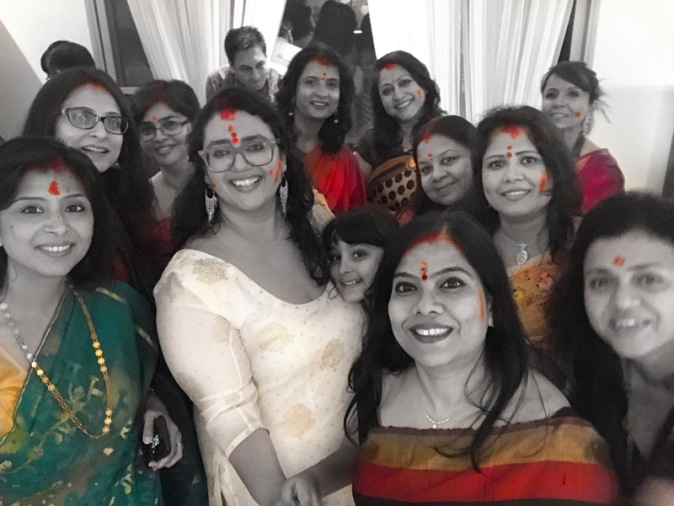

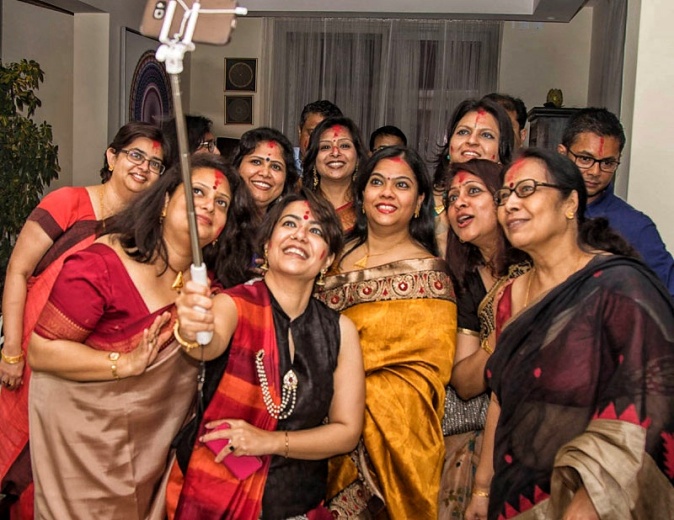
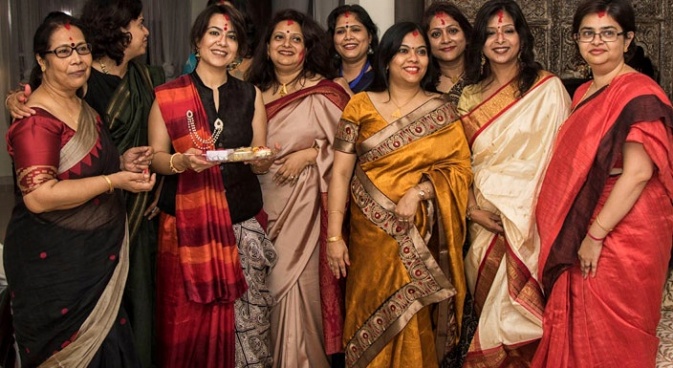
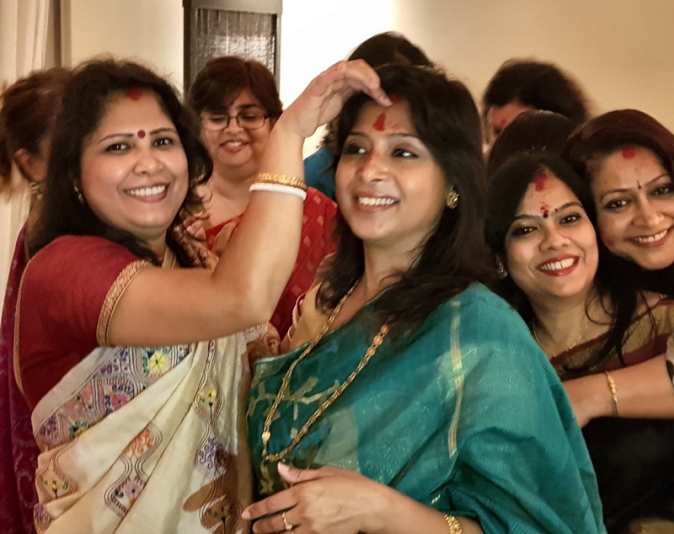
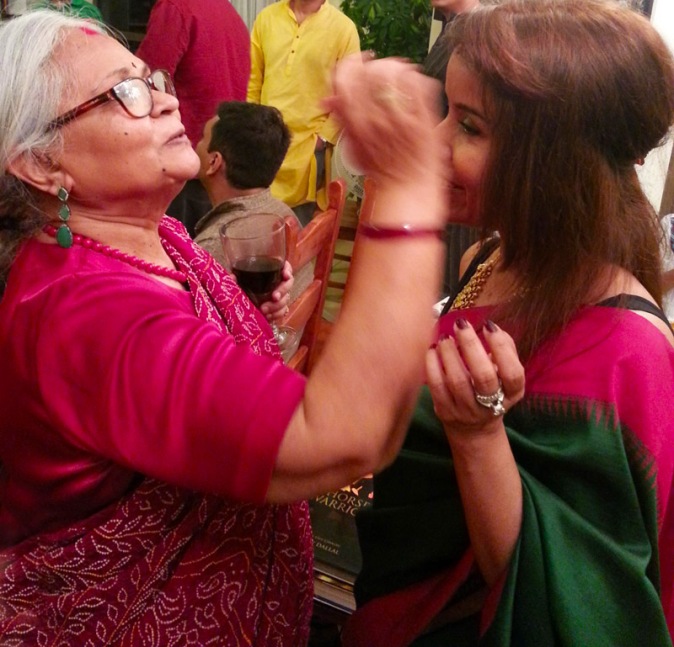
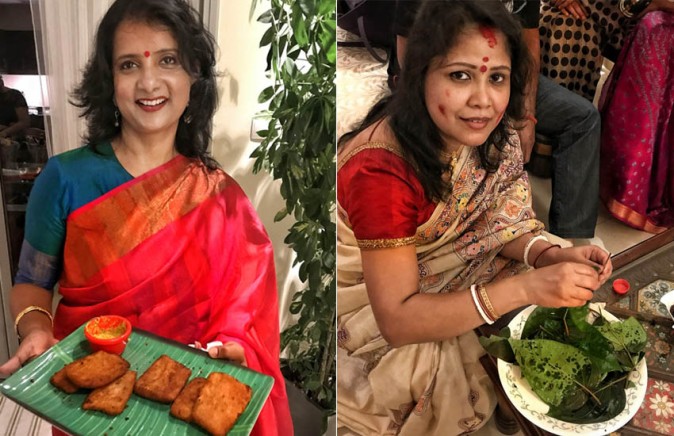
Whether it is the nine yard draping of a traditional sari, the shakha-pala adorned by the married Bengali woman – the white bangles made from conch-shell and the red bangles made of red corals, or the smearing of the red sindoor/vermilion on the forehead, the vibrancy of the red and white combination that I have grown up watching, is quite addictive. You may want to try out new things, but come Bijoya Dashami… the duotone outdoes all the others in the colour wheel. This year too, we ushered in Bijoya with a small gathering at home, a day earlier on Nobomi to coincide with our weekend. The menu was traditional and consisted of fish fry and mochar chop for starters (I also intended to make some aam paana vodka shots, which I forgot!) followed by the mains – beguni, potol bhaja, luchi, aloor dom, iliish maach bhaja, bhoger khichuri (a bit different from the khichuri recipe I have on my blog), mangsho, tomato khejurer chutney. Desserts consisted of notun gurer payesh, malpoa and a rum cake (courtesy friends) and signing off with the signatory paan. The requests pouring in from friends were endless – if the menu had mansho, then there had to be luchi and the luchi had to be phulko or perfectly puffed up (and if you still don’t know my obsession with it, read my ode to phulko luchi), begunis had to be crispy and hot, preferably not pre-fried. The same went for iliish maach bhaaja. Calcutta Fast Food in Sharjah very kindly took up my delicate proposal of ‘part-catering’, if there can be a word like that. A small live cooking section was arranged outdoors in the garden for frying the fish, mochar chop, beguni, luchi, ilissh maach. The sequence in which these needed to be fried also required some serious attention (and strategy) – the first two in the above list were to be served as starters, and the rest had to be doled out almost simultaneously during the main dinner. Not to forget the delicate balance of not frying too much too early on, or take the cue that the oil in which the iliish maach was fried wasn’t the same for frying the luchi!
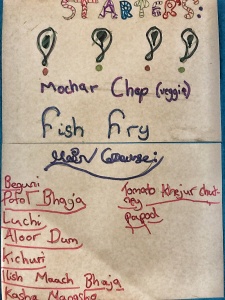
♥ ♥ ♥ Lil Z created a cute hand written menu (left) which, I forgot to place along with the food. She is still upset with me and nothing can compensate this, not even posting it on my blog now because the moment is gone – it is a three-fold card with intricate design of a hand holding the card and the fingers wearing glittery rings. That brings me back to an issue that I seriously suffer from – always forgetting to serve something that has been created specially for the guests, for example, the chutney which is always left waiting in the fridge!
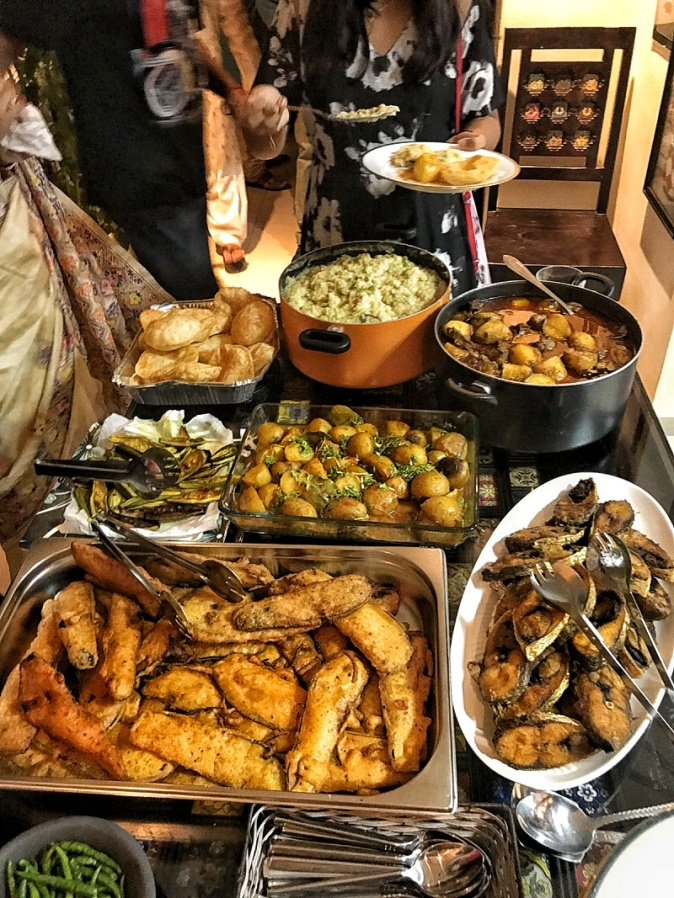
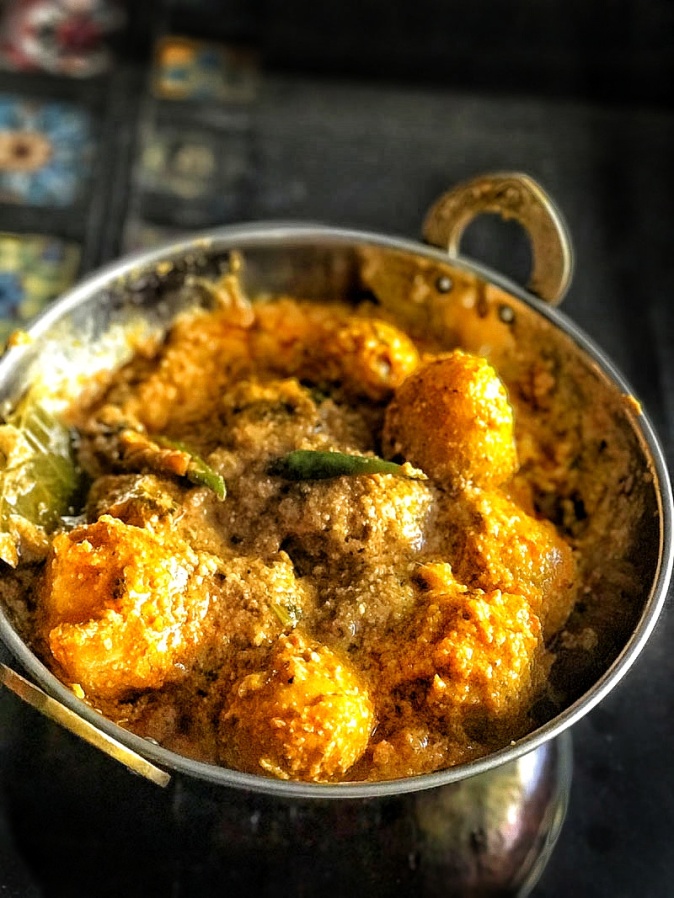
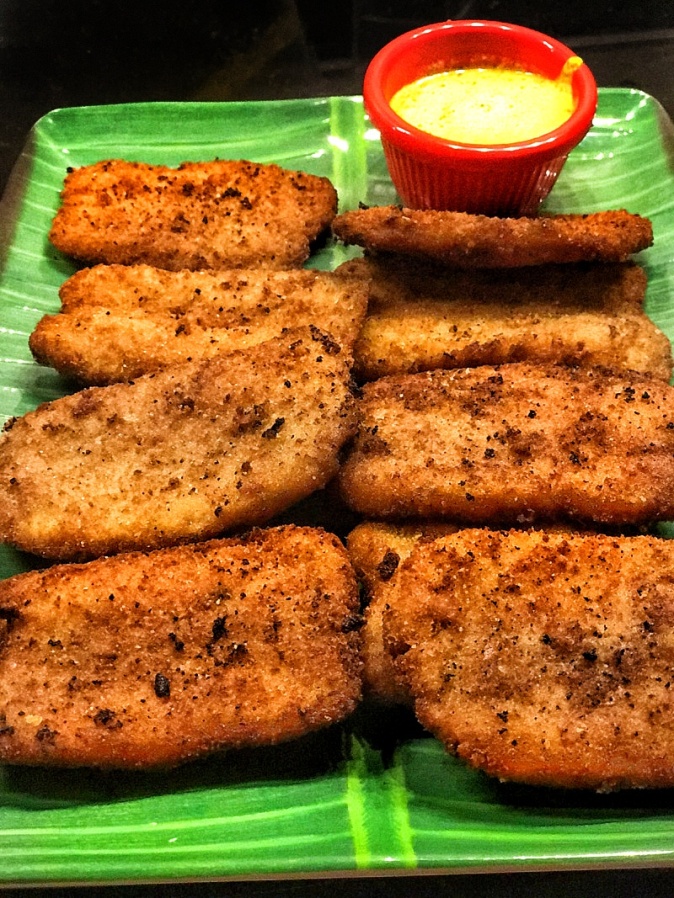
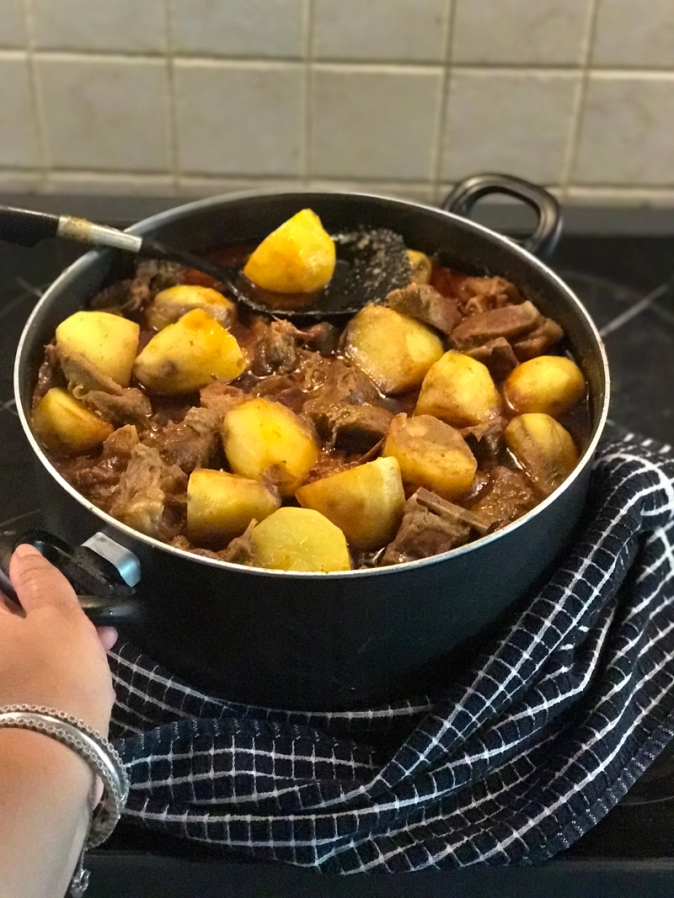
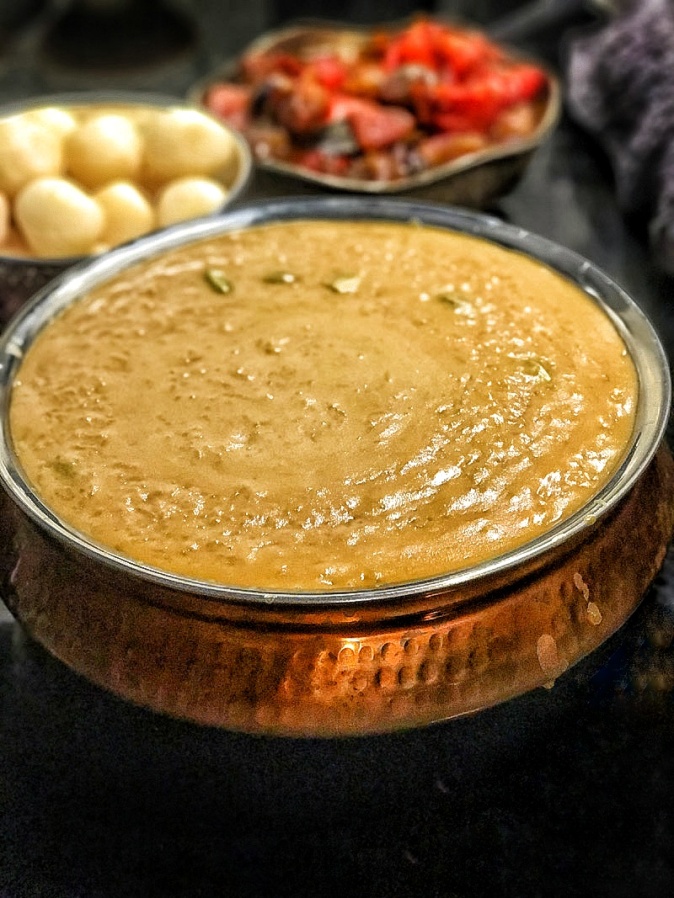
The Bearded Biker leaves no stone unturned for me to materialise a menu. So a few days earlier, after office, we dashed off to the Backet Supermarket in Rolla in Sharjah, the Bangladeshi wholesaler for Bengali fish and foodstuff. If it had to be iliish, it had to be from the Backet, he said. We decided that we would provide the iliish maach and the mustard oil for frying them, for our part-catering. A 12kgs Katla fish was dangling in our way and was way too tempting but we stuck to our list – for once! The special rice used for making bhoger khichuri and the payesh – the chinigura, which is a good substitute for Gobindobhog and the potol also came along with us from Backet. So did the special gondhoraj lebu, the Bengal lime which has a similar aroma to Thai kaffir limes. Salimbhai (below), helped me to choose the perfectly rounded aloo for my aloor dom and the barrel shaped perfect potols. He also promised that the iliish would taste heavenly and it indeed did so. Although, our need for Bengali fish is adequately met at Mefroze in Karama or from a Bangladeshi shop in Bur Dubai most of the times, this dinner needed to be special. After all, the preparation for a special celebration and it’s anticipation is in a way, a subtle infusion of love and warmth into the moments we create for keepsake memories.
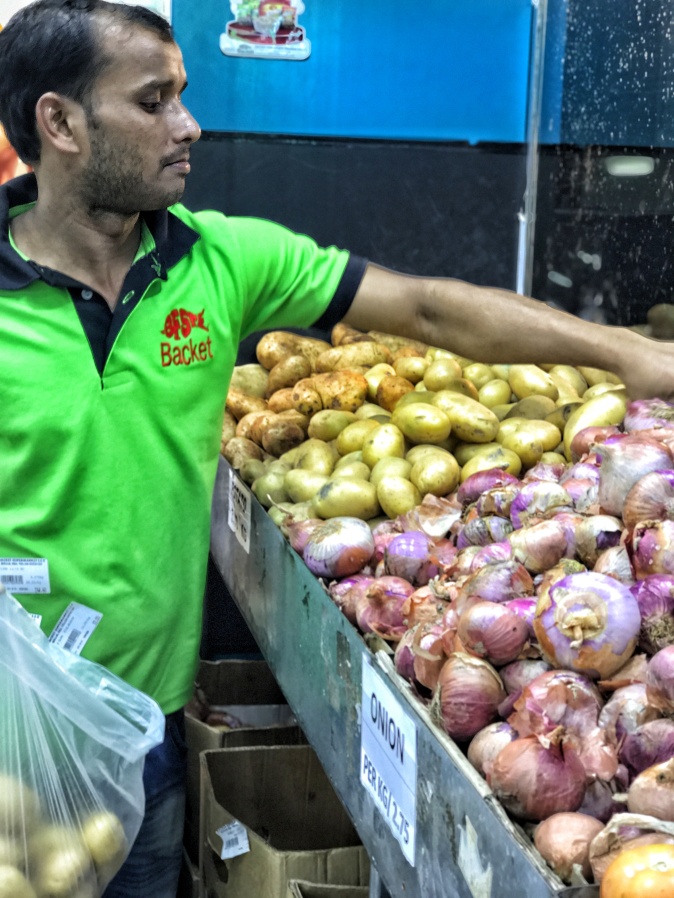
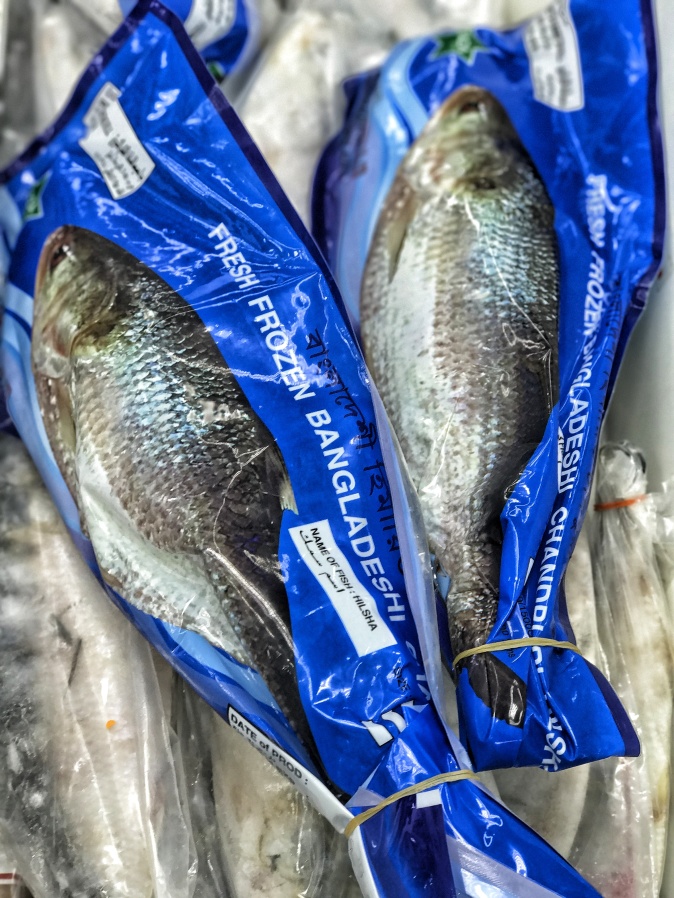
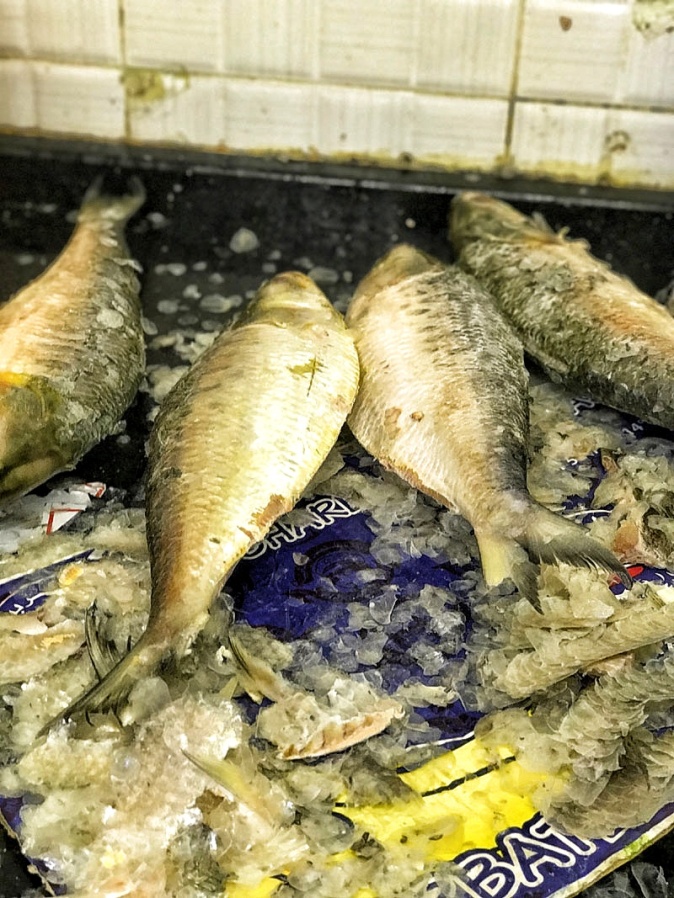
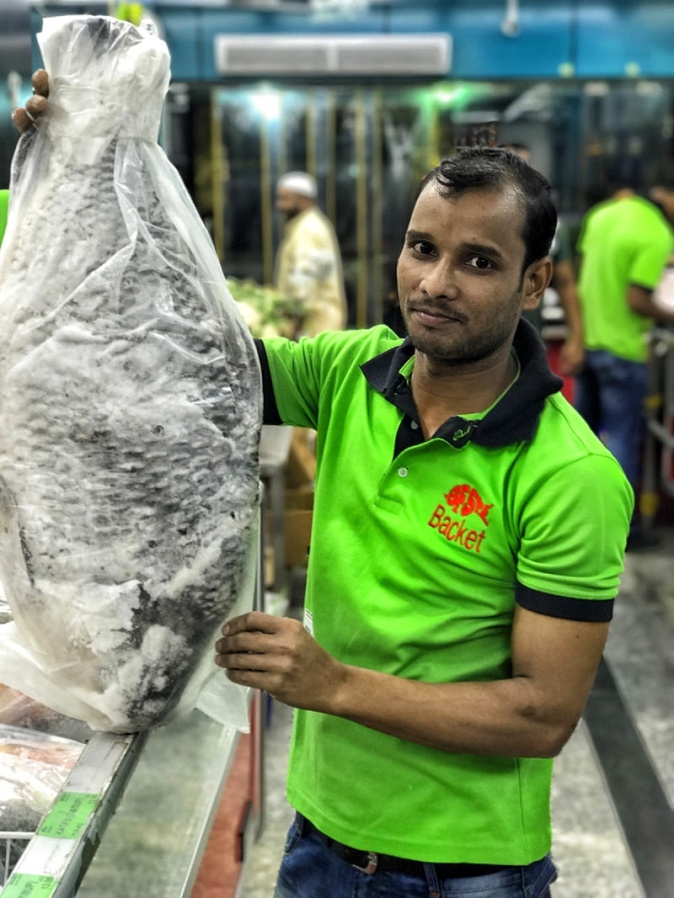
The only time when fashion has to complement food in my blog, is during Pujo. As more and more metropolitan cities in India (and all over the world) are moving towards homogenisation, people are opting out of traditional wear in their daily lives and choosing to wear clothings that are convenient, practical and fuss free. And rightfully so. Festivals and special celebrations are becoming once-in a while special occasions that deserve special adornments. I am hoping that these pictures from my personal album reflect the richness of Bengali culture, despite being diluted in our adaptation at foreign shores. My brother also shared a picture of my Ma and Baba dressed up for Bijoya Sammelani (below) and this was my social media newbie Baba’s first pujo update on Facebook wishing everyone! I also dug into my archives for a picture of my mum-in-law during pujo… she hasn’t yet learnt to take a pujo selfie this year, hence no real evidence of her participation in the pujo. Big Z was a year old in the picture, taken at Iron Side Road in Kolkata, the residential complex where we lived for many years after we shifted from the Magistrate’s House. The stark redness of the sindoor, the crispness of the new saris, the beats of the dhol/ drums from the pandals, the early morning chanting of the priests, and the endless wait for the narkel narus/coconut truffles after the pushpanjali was over – I can feel everything vividly in my senses even today… wherever in the world I am. My brother has been updating live (on social media, of course) from the different pandals that he’s been visiting. I am sharing one of the theme pujos that caught my fancy (do check out his instagram handles @streetbizz and @inbitsnpieces capturing the eclectic world of street vendors and their pursuits). He writes: ‘Modern man’s self obsession with mobiles, is reflected in the theme of this North Kolkata Pujo capturing the attention of the selfie crazy instagram & snapchat generation’. I am sharing a gallery of his beautiful images. And while we are still on the subject, my friend Meher’s write up in Gulf News… ‘Tame that shrew called social media‘, makes for an interesting read.
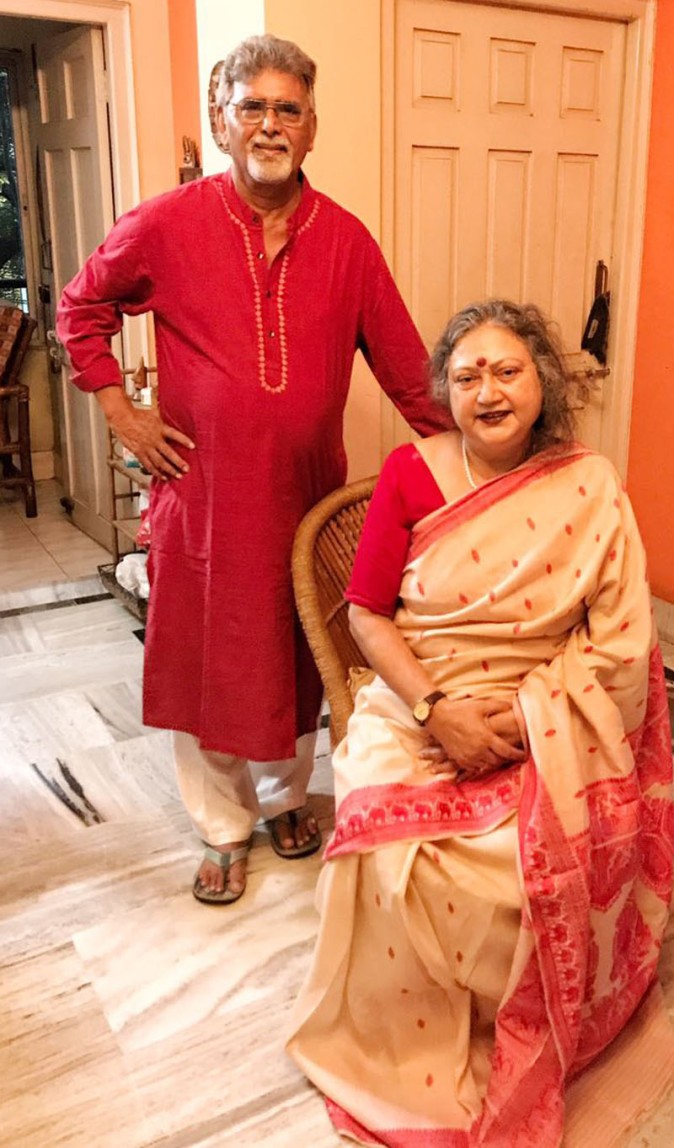
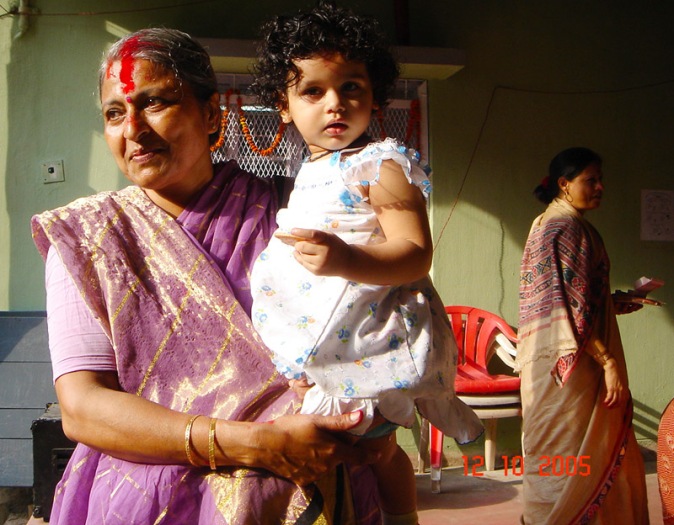
As I sign off, wishing you all a life filled with happiness, prosperity and peace, my thoughts are with all those people affected by the incidents in Las Vegas today … or Barcelona a few days ago… or the quakes in Mexico… or the stampede at Elphinstone Road Station … or… or… the list is endless. How can we pledge for more tolerance? How can we nurture a non-judgemental society that is more compassionate, kind and respectful than it’s previous generation – and that cares for every fellow human being, irrespective of his/her religion, sexuality, ideology and geographical origin? And I beg you not to ask the nittygritties of my religion (a few challenging remarks have started pouring in recently). For I know nothing. I don’t have a particular religion. All I know is that I have embraced many things from many religion and many philosophies that have resonated with me… I chant Buddhist mantra and seek solace in praying the rosary, soak in the muezzin’s call for prayers and shut my eyes in veneration as I offer flowers to the deities in temples. And I derive the same sense of worshipping when I cook for my family and friends… and try to bring a few hearts together to sew a few good memories!
Unblogging it all… Ishita
Pssst: I have been shortlisted in the Top 10 list in the BBC GoodFood Awards ME 2017 under the ‘Food Influencer’ category. Do cast your votes for me to win!
Image credit: My friends – Bireswar, Soumitro, Nilanjana, Sumana; my brother Aveek and myself
Disclaimer: This isn’t a sponsored post, nor are there any affiliated links. The subject, story, opinions and views stated here are my own. While you enjoy reading my posts with lot of visuals, please do not use any material from these posts. Do join me on my daily food and travel journey on Instagram, Facebook, Twitter and Pinterest.











What an amazing journey Chotai…your words and penned expressions actually made me visualise Pujo in glory and grandeur…
Each picture was a story by itself….Bangali der bhuri bhojan seemed as as spiritual as giving pushpanjali..😘😘😘( it really is!)
Loved the happy faces of all the people…
Jai Maa Durga!!!
Ashcchey bocchor abaar hobe….🌺🌺🌺🌺
LikeLike
Thank you Indranimashi… it is absolutely true though that bhuri bhojan is as spiritual as giving pushpanjali. Hope you had a lovely time as well. And yes, ashcchey bocchor abaar hobe… bocchor bochor aabar hobe!
LikeLike
Fantastic visuals…and I have always been a fan of your writing…more power to you and to the expressions of your passions💕
P.S. Have voted & keeping my fingers crossed!
LikeLike
Thank you so much… blessed to having loving and such supportive friends around me. (Fish) Finger Crossed!
LikeLike
Wonderful write up as always. Shubho Bijoya to you and the entire family. Pronams to elders and bhalobasha and shubhechha to youngers. I was interested in the sourcing part of the materials for your bengali cooking and whats your opinion ? The Bangladeshi Ilish that you get there is better than the ones that we get here?
LikeLike
Thank you very much Anindyo and if I may copy paste this too… Pronams to elders and bhalobasha and shubhechha to youngers! My opinion is not as important as my father-in-law’s, who’s a snooty Pescetarian, if you know what I mean. Even he approves the fish that we buy from these Bangladeshi shops… yes, they are frozen but they are caught fresh and immediately frozen (even the Kois packed in Thailand have the seal – site froezen)… and often retain their freshness much more than the ones that we get in Kolkata bazaar. Definitely the Bangladeshi Iliish that we get here is better than the Bangladeshi Ilish you get there (and cheaper).
LikeLike
Sounds like a grande time, and I am loving all the colourful photos. But that handwritten menu from Little Z is the cutest, hope she has forgiven you!
LikeLike
Thank you so much Zeyna… hopefully she has… I mean I have given her enough opportunities to be upset again!
LikeLiked by 1 person
Pingback: When you finally move out of Dubai… which restaurant would you like to visit for one last time?
Pingback: A-Z of Bengali Fish
Pingback: Shubho Noboborsho | A traditional Bengali menu for Frying Pan Diaries podcast
Pingback: Traditional Bengali Cuisine | All The ‘Slight’ Details
Pingback: A colourful weekend and Gajar Ka Halwa with Rabri Mousse and Shahi Tukda – IshitaUnblogged
Pingback: Finally calling Chennai home – IshitaUnblogged